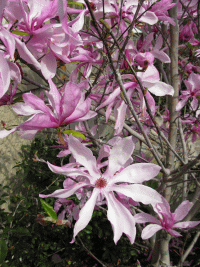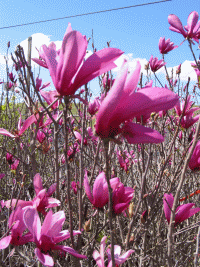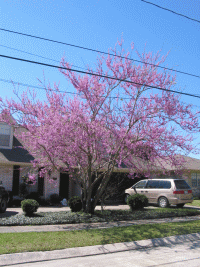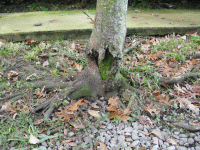
Trees are an integral part of any landscape. They provide the foundation of all outdoors, from the smallest garden to the largest park. Small or large, trees serve many purposes:
- Tree leaves clean the air we breathe by absorbing carbon dioxide and providing oxygen.
- Trees beautify public spaces long term.
- Trees cool the air around them and provide shady retreats.
- Many tree species provide shelter and food for wildlife.
- Larger trees provide windbreaks for homes in high winds.
- Large trees also lower the cost of heating and cooling homes by blocking the sun in summer and blocking cold winds in the winter. Deciduous trees allow sunlight to warm your home in colder months, while still providing a windbreak.
- Trees protect houses situated in noisy environments by blocking sound waves.
- Trees can provide a snow fence in colder climates.
- Strategically placed healthy trees will increase your property’s value.

Prime tree planting season in South Louisiana is November through early March. Trees and many woody shrubs are dormant in the cooler months, so transplanting them now allows them to get situated before spring’s major push to grow begins. Once situated, trees can take on our hot and humid summers more easily.
Woody shrubs and flowering trees in our area are beginning to pop in March. Azaleas, Camellias, and Roses are budding heavily and blooming. Locally grown trees such as Eastern Redbud, Japanese Magnolia, Bradford Pear, Flowering Crabapple, Swamp Red Maple and Taiwan Flowering Cherry are all showing their colors this month. Crape Myrtle, Vitex, Silverbell, Little Gem Magnolia, and Fringe Trees are not far behind. Whether planted as a group or standing alone, these trees are enchanting.
Hardwoods such as Live Oak, Willow Oak, Shumard Oak, Elm, Cypress, Ginkgo, Ash, Hollies, Swamp Red Maple, and Southern Magnolias are stand-alone trees. They need space and are an anchor to any landscape. They are long-lived mostly, so a decision to plant one should be made taking their size and longevity into consideration.
After choosing the best spot to plant your tree, use a pitch fork or garden fork to loosen the soil in a circumference several times the size of the root ball. Dig a hole at least twice as large as the root ball, but no deeper. If the soil is hard, roughen the edges of the hole before settling in the root ball.

Score the root ball with a sharp knife, which will stimulate new root growth. Settle the root ball in the hole and make sure it’s straight. Backfill with the original soil, but only halfway and tamp down gently. It’s tempting to augment the soil when planting a tree, but don’t. The tree needs to acclimate to its home soil. Fill the hole with water slowly. Fill the rest of the hole with soil once the water seeps in.
Cover the entire loosened area with 3-4 inches of mulch. Mulching is very important, as it slows water loss, protects and keeps the roots cool, and reduces weeds. Keep the mulch slightly away from the trunk. Mulching also discourages weed-wacking, which can damage or kill a young tree in no time. If you install a plastic trunk protector, be sure it is the kind that can expand, so it doesn’t girdle the trunk as the tree grows.
The Buckmoth caterpillar voraciously eats the foliage of local oak trees and has a nasty sting that can harm humans and pets. Once the caterpillars start hatching, you can have your tree (and your neighbors’) sprayed to reduce the population. Spring defoliation by caterpillars can lead to damage that the trees cannot overcome.
For planting trees in public spaces (parks, easements, neutral grounds), contact the Department of Parks and Parkways at 504-658-3200 or call Parkway Partners 504-620-2224 for more information. For more information on suitable trees for our area, consult the LSU AgCenter publication “Tree Ratings for the New Orleans Area” which describes the pros and cons of many trees that can be used here and also the “Native Tree Planting Guide” both of which can be found at lsu agcenter.com.

submitted by Nell Howard
